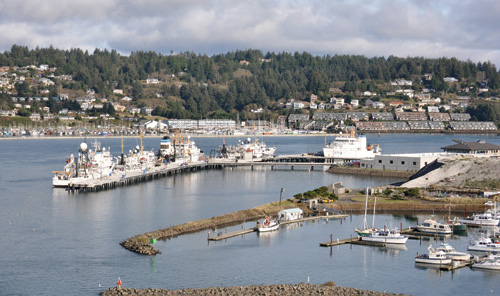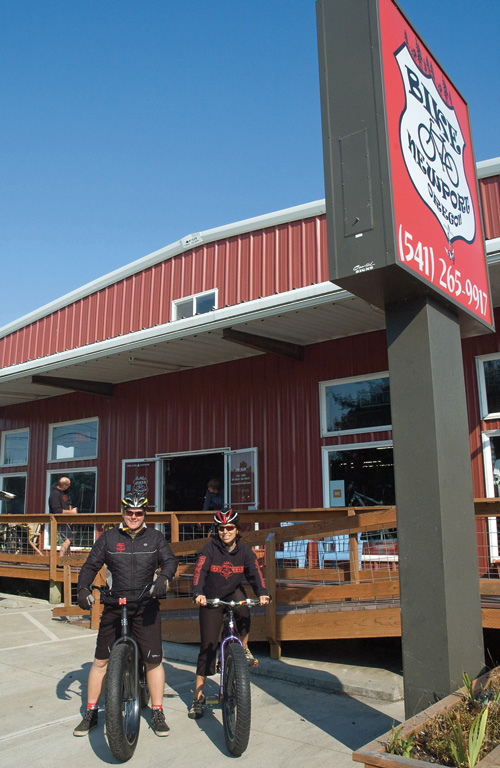 For small businesses in Newport like Elliott and Daniella Crowder’s Bike Newport, increased activity in marine science has helped boost business in a town traditionally driven by fishing, tourism and logging.
For small businesses in Newport like Elliott and Daniella Crowder’s Bike Newport, increased activity in marine science has helped boost business in a town traditionally driven by fishing, tourism and logging.
By Jon Bell
 |
For small businesses in Newport like Elliott and Daniella Crowder’s Bike Newport, increased activity in marine science has helped boost business in a town traditionally driven by fishing, tourism and logging. “Things are starting to move toward a lot of marine science, research, education and business,” Daniella Crowder says. “Now that the NOAA ships are in, I believe businesses are starting to see an economic impact. I know we have.” |
Daniella and Elliott Crowder have owned their coastal bike shop, Bike Newport, since 2005, when they sold their restaurant in Grants Pass and headed for Newport. In that time, they’ve built a solid biking business and because they also offer laundry, showers and a lounge, the shop has become a destination for hundreds of cyclists who pedal the length of the Oregon Coast every summer.
In addition, the Crowders have found themselves catering to another niche in Newport as well: riders related to the hub of marine science and ocean research that’s been rising in Newport over the past few years. Not only does Bike Newport do a decent amount of business with employees of Oregon State University’s Hatfield Marine Science Center, but several of those employees also make up the shop’s racing team. And since the National Oceanic and Atmospheric Administration moved its Pacific Marine Operations Center to Newport from Seattle in 2011, the Crowders have been servicing many NOAA employees, many of whom bike as their main mode of on-land transportation.
“We have personally seen a lot of repair business from the NOAA staff and ships,” says Daniella Crowder. “The crews often have bikes on board to use when they get to a new port and they take quite a beating when out at sea.”
The anecdotal uptick is a sign to Crowder and others in Newport that NOAA, the HMSC and other endeavors associated with oceanic research are starting to make economic waves alongside the small community’s more traditional economic engines.
“The traditional economic structure in Newport has always been fishing, tourism and logging,” says Shawn Rowe, a marine education and learning specialist at HMSC, “and while none of those are going away, now there’s a fourth leg of the stool around ocean sciences.”
Although the NOAA relocation — its $38 million facilities, six ships, estimated 175 jobs and potential economic impact of nearly $20 million a year — has grabbed most of the attention around Newport of late, other research-related endeavors have been churning as well. At the science center, Rowe is also the director of education for Oregon Sea Grant, which is part of a national organization that funds research in coastal and Great Lakes states. In October, the National Science Foundation awarded Oregon Sea Grant a five-year, $2.6 million research grant to study how people learn across their lifespan and how to improve those experiences.
Newport, which is home to not only the HMSC but also the Oregon Aquarium, is an ideal place for such research, Rowe says, in part because of the sheer number of people who visit both places for educational experiences. HMSC, which employs close to 300 people, sees 150,000 visitors a year, including 12,000 students, and the aquarium draws nearly half a million.
Even though the grant will result in only two jobs, Rowe says receiving such a large grant — the largest in Oregon Sea Grant’s 40-year history — from a prominent national foundation will help further boost HMSC toward the ranks of big-league ocean research centers like the renowned Scripps Institution of Oceanography in San Diego.
“We are becoming a hub for this kind of activity,” Rowe says, “and Hatfield is getting up into that same league.”
 |
NOAA’s new Pacific Marine Operations Center in Newport (shown here) could attract more than $17 million in new research grants to institutions such as the Hatfield Marine Science Center. |
In addition, the grant is just one of many research projects under way in Newport, many of which require charter boat services, housing for researchers and other local services. Hatfield also partners with eight state and federal agencies involved with marine research, five different colleges at OSU and the Northwest National Marine Renewable Energy Center.
“Marine research really has a potential to be a growing industry and to become one of the drivers here,” says Caroline Bauman, executive director of the Economic Development Alliance of Lincoln County.
Bauman is among a group of government officials, industry representatives and scientists behind the Yaquina Bay Ocean Observing Initiative, which aims to pursue economic development opportunities related to ocean-observing activities. Those include not only research, but also wave energy development, commercial fishing, seafood processing and other similar fields.
The effort toward capitalizing on Newport’s research endeavors melds nicely with some of the other ocean-based activities that have been on the upswing over the past year or so. The Port of Newport, which is the landlord for both Hatfield and the new NOAA facility, has seen a nice uptick in activity with the arrival of NOAA’s fleet. The ships are out at sea for much of the spring and summer months, but when they are in port, NOAA employees are utilizing local repair and supply services, including those at a newly renovated boatyard upriver in Toledo, frequenting local shops and restaurants and living in the city.
“We have five large vessels tied to the pier right now and gearing up for fisheries and weather research in the spring all up and down the West Coast,” says Don Mann, general manager of the port. “That’s activity that we haven’t had before and that will be an ongoing contribution to the entire region.”
The port is also one of the three largest on the Oregon Coast and is a major player in both the Oregon and Pacific fishing industry. Between 70 and 100 fishing boats pass through the port each month, and in 2010, according to Mann, Newport landed 57 million pounds of fish, ranking it No. 20 in the nation in terms of total pounds landed. The value of its annual haul that year was $30.6 million, plus an additional $32 million from the distant water fleet, which comprises vessels that fish in other waters, including Alaska.
“They make that trip twice a year, but many of them have their homes here,” Mann says, “so most of their money comes back here.”
The port is also in the middle of a multi-million dollar project to rebuild its international terminal, which could lead to increased opportunities for exporting and importing logs and other cargo, something the port hasn’t seen in more than a decade.
“We’re looking forward to the growth in marine science research,” Mann says, “but we’ve also seen a significant increase in interest in cargo, so hopefully by this time next year, [the terminal] be back in business.”


